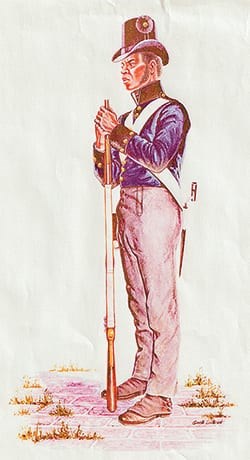If quizzed, “How influential were African Canadians in the settling of Canada,” most Canadians likely wouldn’t know. Yet by 1793 there was a successful Black settlement right here in the Niagara Peninsula, what was then known as Upper Canada. These free Black men not only had their own farms and businesses, they served valiantly during the war of 1812.
When the American Revolution ended in 1783, old grievances remained south of the border. Anyone who had been loyal to King George was persecuted, especially the African slaves who joined the British Army when it was learned that to do so guaranteed their freedom. So when the British lost their possessions in the newly formed United States, both Black and white residents faced life-threatening persecution.

Upon learning of their plight, with the many petitions sent to England, King George gave these “Loyalists” land to settle in Upper Canada, now Ontario. Veterans of the King’s service, both Black and white, received 200 acres each.
Settling in Upper Canada wasn’t easy. Conditions to keep your land required that by the first year ten acres had to be cleared and a cabin or homestead had to be built. Those who could meet the requirement and convert the land to farming made good money. Those who couldn’t often sold their land and bought into various businesses. Many of those Black settlers ended up in Shipman’s Corners (now St. Catharines), Niagara-on-the-Lake, and Pelham, as their British land grants allotted.
What is noteworthy is that by 1793 the majority of white settlers were abolitionists and sympathetic to the plight of the Africans who settled here. The Act Against Slavery was signed that year, and St. Mark’s Anglican Church in Niagara-on-the-Lake gives detailed accounts of the Black men who were marrying white women in that community.
By 1812 dark clouds of war were gathering over the Niagara Peninsula, with the United States looking at this fledgling British settlement as easy pickings. But General Isaac Brock had no intentions of giving in without a fight. He called all men aged 16-60 into the militia and trained them alongside his British regulars. Both Black and white citizen soldiers were paid equal rations and equal pay.
In the spring of 1812, an African Loyalist, Richard Pierpoint, who served with the British against the Americans during the Revolutionary War, wrote to General Brock requesting the formation of an all-Black fighting company. Brock didn’t respond at first. He most likely was concerned about the cohesion of an already ethnically diverse army and militia with Scottish, Welsh, Irish, Germans and American Loyalists in his ranks. But on August 28, shortly after his return from a triumphant victory at Detroit, Brock granted Pierpoint’s request. Brock promoted white Sergeant Robert Runchey to captain and to command the newly formed Coloured Corps.
The Coloured Corps served with distinction from 1812-1814, with not one incident of desertion. In October of 1812, the Coloured Corps fought alongside Mohawk chief Captain John Norton and the First Nations to rid the Village of Queenston of the American invaders there. Later that day at Queenston Heights, the Coloured Corps skirmished alongside the First Nations using hit and run tactics, pinning the American invaders from further advancement into Canada, until they later united with the British Army to plunge the Americans into the gorge of the Niagara River, sealing their defeat.
The trade skills these Black settlers possessed were in great need by the British Army. By 1813, Captain Runchey’s Coloured Corps was reassigned from infantry support to the Engineering Company. They were the artificers who built Fort Mississauga, which stands to this day.
The Coloured Corps served at the battles to retake Ft. George and Ft. Erie. They were at the battles of St. David’s, Stoney Creek, Burlington Heights, and Lundy’s Lane.
But their distinguished service did not end when the war ended in 1814. When extensions were approved to expand the first Welland Canal, circa 1843, the Coloured Corps was called to duty again. But this time their engineering skills were not called upon—instead they served as the federal police force that kept the Irish gangs from fighting each other.
Canada owes a great debt of gratitude to the British who put up the financial capital to build this country, to the First Nations who put up the muscle and sacrifice to keep it, and to the African-Canadians who served it with distinction and honour.


